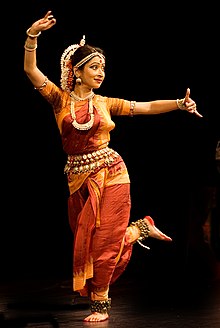ব্যবহারকারী:Moutushi chanda/Odissi (1)

Odissi, also known as Orissi (Odia: ଓଡିଶୀ Oḍiśī), is one of the eight classical dance forms of India.[১][২][৩][৪] It originates from the state of Odisha, in eastern India. It is the oldest surviving dance form of India on the basis of archaeological evidences.[৫][৬] The classic treatise of Indian dance, Natya Shastra, refers to it as Odra-Magadhi. 1st century BCE bas-reliefs in the hills of Udaygiri (near Bhubaneswar) testify to its antiquity. It was suppressed under the British Rule, but has been reconstructed since India gained independence. It is particularly distinguished from other classical Indian dance forms by the importance it places upon the Tribhangi (literally: three parts break), the independent movement of head, chest and pelvis[৭][৮] and upon the basic square stance known as Chauka or Chouka that symbolises Lord Jagannath. This dance is characterised by various Bhangas (Stance), which involves stamping of the foot and striking various postures as seen in Indian sculptures. The common Bhangas are Bhanga, Abanga, Atibhanga and Tribhanga.
Though a very old dance form, Odissi got recognition as a classical dance from the Central government officially, after efforts by many scholars and performers in the 1950s, including a powerful lec-dem in April 1958 by Kavichandra Kalicharan Pattanayak, an Oriya poet, dramatist and researcher. Pattanayak is also credited with naming the dance form as "Odissi".[৯]
- Mangalacharana
- An invocation piece. After paying homage to Lord Jagannath a shloka (hymn) in praise of some God or Goddess is sung, the meaning of which is brought out through dance. Mangalacharan also includes the Bhumi Pranam (salutation to Mother Earth) which is offered to Mother Earth as a way of begging forgiveness for stamping on her and the Trikhandi Pranam or the three-fold salutation – above the head to the Gods, in front of the face to the gurus and in front of the chest to the audience.
- Battu Nrutya
- Also known as Sthayee Nrutya or Batuka Bhairava (Furious Dance) it is performed in the honor of Lord Shiva- the cosmic Lord of Dance. It is one of the 64 furious-aspects of Lord Shiva known. The origin of dance is believed to be from Tantrism that had flourished in Odisha. Linga Purana and Mahanirvanatantra give an elaborate description of Batuka Bhairava in three aspects, and the results of their worship have also been explained elaborately in the texts. Battu Nrutya is an item of pure Nrutya (Dance)and remains the most difficult item of Odissi dance. The dance begins with a series of sculpturesque poses depicting such actions as the playing of a Veena (Lute), Mardala or Pakhawaj (Drum), Karatala (Cymbals) and Venu (Flute), that brings out the interrelationships between this dance and the dance sculptures adorning the temples of Odisha. These poses are stringed together with steps in different rhythms. There is no song or recitation accompanying the dance, but throughout the item a refrain of rhythmic syllables is provided. The accompanying refrain is in the form of one line of Ukuta and as this is recited in the Tala, different Jathi-patterns are improvised and are executed with the feet. Some Tala variations are introduced and each sequence of the dance terminates with a Tehdi known as Katam. The last sequence is always in Jhula Pahapata Tala and is performed with a fast tempo.
- Abhinaya
- An expressional dance which is an enactment of a song or poetry, where a story conveyed to the audience through mudras (hand gestures), bhavas (facial expression), eye movement and body movement. The dance is fluid, very graceful, and sensual. Abhinaya can be performed on verses in Sanskrit or Odia language. The verses are extremely ornate in content and suggestion. Most common are Abhinayas on Oriya songs or Sanskrit Ashthapadis or Sanskrit stutis like Dasavatar Stotram (depicting the ten incarnations of Lord Vishnu) or Ardhanari Stotram. Most of the Abhinaya compositions are based on the Radha-Krishna theme. The Astapadis of the kãvya Gita Govinda written by the Saint Jayadev are an integral part of its repertoire. The beginning pieces are dedicated to Lord Jagannath – an incarnation of Lord Vishnu.[১০]
References[সম্পাদনা]
- ↑ http://ccrtindia.gov.in/classicaldances.php Centre for Cultural Resources and Training (CCRT)
- ↑ http://sangeetnatak.gov.in/sna/guide-snaawards.htm Guidelines for Sangeet Natak Akademi Ratna and Akademi Puraskar
- ↑ http://ccrtindia.gov.in/performingart.php Centre for Cultural Resources and Training (CCRT)- Performing Arts
- ↑ http://knowindia.gov.in/knowindia/culture_heritage.php?id=101 India Ministry of Culture
- ↑ www.
- ↑ "Odissi Kala Kendra".
- ↑ Article by David Courtney retrieved July 2008
- ↑ Sehgal, Sunil (1999).
- ↑ David Dennen.
- ↑ "Odissi".
